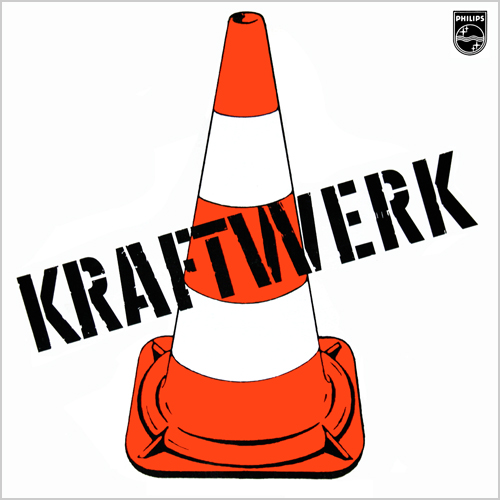- Kraftwerk (album)
Infobox Album |
Name = Kraftwerk

Type = studio
Artist =Kraftwerk
Released = 1970 -Germany
Released later in other countries
Recorded = July - September 1970
Genre =Krautrock Electronic music
Length = 39:39
Label =Philips
flagicon|Germany flagicon|France flagicon|Japan
Producer =Conny Plank Ralf Hütter Florian Schneider
Reviews =
*Allmusic Rating|3|5 [http://www.allmusic.com/cg/amg.dll?p=amg&sql=Ags4gtq3ztu43 link]
Last album = "Tone Float "
(1970)
This album = "Kraftwerk"
(1970)
Next album = "Kraftwerk 2 "
(1972)"Kraftwerk" is the first album by
Kraftwerk . It was released in Germany in 1970, produced by the influential Konrad "Conny" Plank.Hütter and Schneider used two drummers during the recording of the album;
Andreas Hohmann andKlaus Dinger . Their playing provides the music with a rock edge. This proves to be quite distinct from Hütter and Schneider's previous band Organisation, or the following pair of Kraftwerk albums,Kraftwerk 2 andRalf und Florian which were both recorded entirely as a duo by Hütter and Schneider. According to later interviews with Dinger, he plays on side two ("Vom Himmel Hoch"), while Hohmann plays on side one ("Ruckzuck", "Stratovarius"), which was completed before Dinger joined the sessions.The other instrumentation features Hütter on
Hammond organ and a modified electric organ called a "tubon" (made by swedish factory Joh Mustad AB), whilst Schneider supplied manipulated flute. The song, "Ruckzuck" is driven by a powerful multi-dubbed flute riff, along with electric violin and guitar; these instruments often connected to further electronics via anEMS pitch-to-voltage converter.The album tracks are all instrumentals, of which, "Ruckzuck" and "Stratovarius" are closest to a rock music approach in style. "Ruckzuck" has a tightly arranged opening section that includes a dramatic change of tempo, before an extended and largely percussive middle section, with an even faster reprise of the opening theme to end the piece. Following an extended drone opening played on keyboards, "Stratovarius" develops as a looser succession of mainly guitar and drum based jams that build and break down. "Megaherz", a duet played by Hütter and Schneider, begins as a deep, rippling bass tone that steadily expands with electronic treatments to a discordant climax. Following this, there is a meditative middle section played with flute and keyboards, after which the piece closes with a series of wave-like crescendos of increasing intensity. "Vom Himmel Hoch" begins with distant-sounding drones that develop into
Doppler effect sweeps as the keyboards begin to mimic the sound of falling bombs. Eventually, a very coarse rock groove emerges (triggered by the first beats of Dinger's drums), that quickens in tempo and, after a brief sonic interruption, reaches an explosive finalé.A colour video recording from
WDR exists of a concert performance of "Ruckzuck" by Hütter and Schneider's previous band, Organisation, as well as another black and white recording of it being played by the Hütter/Schneider/Dinger line-up of Kraftwerk.The cover design, credited to Ralf Hütter, is a curious nod to the influence of
Andy Warhol and the then contemporaryPop Art movement, featuring a fluorescent-coloured traffic cone drawn in a Warhol-esque manner. The image on the inside of the gatefold sleeve is of a powerplant electricity substation, photographed by Düsseldorf conceptualist artistsBernd and Hilla Becher , known for their photographic "Typologies" [http://www.amazon.com/gp/product/0262025655 Bernd and Hilla Becher: "Typologies"] series that celebrated the industrial and urban environment – and by extension, the society that built it – by showing multiple variations of ordinarily mundane building types.Guitarist Michael Rother joined the band after this album, and remarkably, around the same time Hütter actually left the band for a few months in 1971. The 3-piece Kraftwerk line up of Schneider, Dinger and Rother made a TV appearance on
Radio Bremen TV show "Beat-Club ". After this, Dinger and Rother left to form revered bandNeu! , with Hütter rejoining Schneider to continue Kraftwerk, both parties recording under the mentoring of Conny Plank.No material from this album has been performed in the band's live set since the "Autobahn" tour of 1975, and to date, the album has not been officially reissued on
compact disc . The band are seemingly reluctant to consider it a part of their canon – Schneider in later interviews referred to the first three Kraftwerk albums as "archaeology". However, pirated CD and vinyl pressings of the album have been widely available since the mid-1990s on the Germanofon and Crown labels."Ruckzuck" was used as the theme song for the defunct
PBS show "Newton's Apple " in theUnited States . It was used without permission. Later episodes of the show feature an unknown cover version of the song.Track listing
ide one
#"Ruckzuck" - 7:47 (translates as "Very quickly" with a slight connotation of "Push-pull")
#"Stratovarius" - 12:10 (pun onStratocaster guitars andStradivarius violins)ide two
#"Megaherz" - 9:30 ("Mega-heart" - a pun on "
Megahertz ", the unit of frequency)
#"Vom Himmel Hoch" - 10:12 ("From Heaven above" - the first words ofMartin Luther 's famous Christmas hymn)Credits
*
Ralf Hütter – organ, tubon; cover design.
* Florian Schneider-Esleben – flute, violin, electric percussion.
*Andreas Hohmann – drums.
*Klaus Dinger – drums.
* Konrad "Conny" Plank – sound engineer & production.
*Klaus Löhmer – assistant sound engineer.Release details
References
Wikimedia Foundation. 2010.
